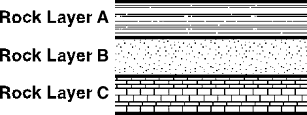
1. Describe three things paleontologists do as part of their jobs.
Many different answers could be appropriate here including, going out into the field to search for fossils, identifying fossils, collecting data, asking questions about life in the past, studying dinosaurs, etc.
2) A scientist is studying fossils in an area where rocks appear in three distinct layers, as in the following diagram:

Which of the rock layers (A, B, or C) is probably the OLDEST? Explain your answer.
Answer: Layer C is probably the oldest layer.
Explanation: Usually the lower layer contains the oldest fossils. This is because sediments pile up through time, burying the oldest fossils deeper and deeper.
3. Circle the animals below that lived in Montana 60-70 million years ago, but no longer live there today.
| crocodiles | horses | dinosaurs |
| ostriches | woolly mammoths | humans |
| multituberculates | rabbits | sharks |
Crocodiles, dinosaurs, multituberculates, and sharks all lived in Montana 60-70 million years ago
but are not found there today.
Paleontologists have found fossils of each of these animals.
4. A scientist counted up all of the fossils she found in one place and listed them in the chart below. She wants to learn about what life was like at this place a long time ago.
| DATA CHART | |||
| Crocodile | Frog | Turtle | |
| Teeth | 147 | 0 | 0 |
| Vertebrae | 98 | 20 | 54 |
| Wrist bones | 7 | 1 | 0 |
Using the numbers from this chart complete the following:
A. Give one conclusion that she could make based on DIRECT EVIDENCE.
Crocodiles were present.
Frogs were present.
Turtles were present.
B. Give one conclusion that she could make based on INDIRECT EVIDENCE.
The presence of crocodiles, frogs, and turtles might be direct evidence that the environment was partially aquatic, and partially terrestrial.
C. Give one conclusion that she could NOT make.
She could not tell how many of each of the organisms were present.
5. If a scientist is presented with the information above to interpret, she should:
Come up with several good explanations and look for more information to help her decide which idea is best.
6. Look closely at the boxes below. Circle the letters that point to the DIAGNOSTIC FEATURES of each box.

C and D are diagnostic features as they are different for each box.